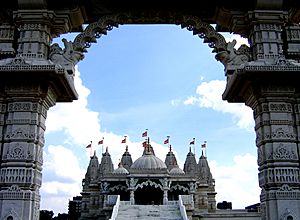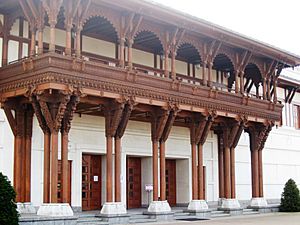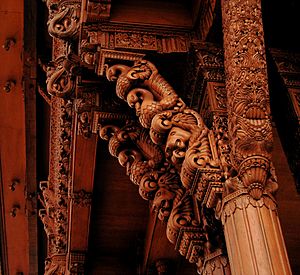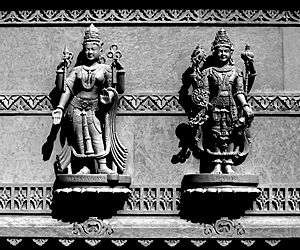BAPS Shri Swaminarayan Mandir London facts for kids
Quick facts for kids BAPS Shri Swaminarayan Mandir London |
|
|---|---|
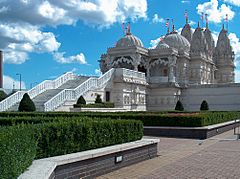
BAPS Shri Swaminarayan Mandir
|
|
| Geography | |
| Coordinates | 51°32′51″N 0°15′42″W / 51.54750°N 0.26167°W |
| Country | United Kingdom |
| Locale | Neasden London, NW10 |
| Architecture | |
| Architectural styles | North Indian |
| History and governance | |
| Creator | Pramukh Swami Maharaj / BAPS |
| Website | http://londonmandir.baps.org/ |
The BAPS Shri Swaminarayan Mandir in Neasden, London, is a beautiful Hindu temple. It is often called the Neasden Temple. This special temple was built using old, traditional methods and materials. It was the first traditional Hindu stone temple in Europe. The temple opened in 1995.
The Guinness World Records 2000 once called it the "Biggest Hindu Temple outside India." It was built by Pramukh Swami Maharaj, a respected spiritual leader. The temple used a lot of special stone: 2,828 tonnes of Bulgarian limestone and 2,000 tonnes of Italian marble. This stone was sent to India to be carved by 1,526 sculptors. The temple cost about £12 million to build.
Since 2000, other BAPS temples have been built that are even bigger. The Neasden Temple was built and paid for entirely by the Hindu community. The whole project took five years, but the main temple building was finished in just two and a half years. Building work started in August 1992.
Contents
About the Neasden Temple Complex
The temple complex is made up of a few important parts:
- A mandir, which is the main temple building. It is made from hand-carved Italian marble and Bulgarian limestone.
- A permanent exhibition called "Understanding Hinduism."
- The BAPS Shri Swaminarayan Haveli, which is a cultural centre. It has a big hall, a gym, a bookshop, and offices.
Building the Main Temple
The mandir is the most important part of the complex. It was designed using ancient Hindu building rules called the Shilpa Shastras. These rules help buildings represent different qualities of God. The temple was built almost entirely from Indian marble, Italian marble, Sardinian granite, and Bulgarian limestone. What's really cool is that no iron or steel was used in its construction. This is very unusual for a modern building in the UK.
The architect, C. B. Sompura, used only stone for the construction. The temple has seven tall pinnacles (spires) on its roof, topped with golden spires. It also has five round domes. The central dome is famous because it doesn't use any steel or lead. Inside, the stone columns are linked by curved stone pieces, making it look like they are floating.
Light cream limestone from Bulgaria was used for the outside of the temple. For the inside, white Italian marble and Indian marble were used. These stones were sent to India, where over 1,500 skilled craftsmen carved them. More than 26,300 carved stone pieces were then sent back to London. The building was put together like a giant 3D jigsaw puzzle.
The temple was officially opened on August 20, 1995, by Pramukh Swami Maharaj. Many people helped build the temple. Over 1,000 volunteers worked on the building. Many more people helped by donating money or organizing fundraising events. Even children helped by collecting aluminum cans for recycling!
What Happens Inside the Temple?
The mandir is a place of worship. Underneath each of the seven spires on the outside, there is a shrine inside. Each shrine holds murtis, which are sacred images of Hindu Gods and Goddesses. These murtis are treated with great respect, as if they are God in person. Monks, called swamis, who live at the temple, take care of them every day.
Below the mandir, there is an exhibition called "Understanding Hinduism." It uses 3D displays, paintings, and traditional crafts to teach visitors about Hindu beliefs and values. You can learn about the history of Hinduism and how it is practiced today. The temple is open to everyone, no matter their religion or background. Entry is free, but there is a small fee to see the "Understanding Hinduism" exhibition.
The Haveli Cultural Centre
Next to the mandir is the BAPS Shri Swaminarayan Haveli. This is a cultural centre that hosts many activities. While the mandir is made of stone, the haveli is built from wood. English oak and Burmese teak wood were carved into beautiful panels, arches, and screens. These carvings were done by craftsmen in India. They feature amazing geometric patterns, animal heads, and flower designs.
The Burmese teak wood used came from forests that are managed sustainably. To make up for the 226 English oak trees used, over 2,300 new English oak trees were planted in Devon. The haveli also has features that save energy, like special light-wells that bring in natural light.
The haveli's design is inspired by traditional Indian haveli architecture from Gujarat, India. It makes you feel like you are in India! Over 150 craftsmen from India spent three years carving the wood for the haveli. Inside, the cultural centre has a huge prayer hall that can hold 3,000 people. It also has a gym, a medical centre, dining areas, a bookshop, and offices.
Daily Life at the Temple
Every day, special rituals are performed for the murtis.
- Before sunrise, the swamis (monks) wake the murtis and open the shrines for the Mangala Aarti. This is the first of five Aarti rituals. Aarti is a prayer where the swamis wave a lighted lamp in front of the murtis.
- The shrines open again for the second Aarti, called Shangar Aarti. They stay open until about 11:00 am.
- At 11:45 am, the shrines open for the midday Aarti, called Rajbhog Aarti. Food is offered to the Deities. After this, the shrines close so the Deities can rest.
- The shrines open again at 4:00 pm (3:30 pm on weekends) for visitors to see the murtis.
- The Sandhya Aarti (sunset Aarti) happens at 7:00 pm. After this, devotees chant names of God and sing hymns. The shrines close for about an hour so the swamis can offer the Deities their final meal.
- Finally, the Deities are prepared for the night. The shrines open one last time for the Shayan Aarti (nighttime Aarti). The lights are dimmed, and soft music plays. Devotees sing hymns to gently send the Deities to sleep before the shrines close for the night.
Awards and Recognition
The Neasden Temple has received many awards and much recognition:
- Pride of Place Award: In December 2007, the temple won the 'UK Pride of Place' award after a national online vote.
- Seven Wonders of London: Time Out magazine called the Mandir one of the "Seven Wonders of London." They chose it as one of the capital's most iconic buildings.
- Guinness World Records: In 2000, Guinness World Records gave the temple two certificates. One was for offering 1,247 vegetarian dishes during the Annakut Festival. The other was for being the largest traditionally built Hindu temple outside India.
- Most Enterprising Building Award: In 1996, the temple won this award from the Royal Fine Art Commission & British Sky Broadcasting.
Getting There
The temple is near the North Circular Road. You can reach it by bus or by walking from nearby Wembley Park, Stonebridge Park, Harlesden, and Neasden Underground and Overground stations.
Temple History
- 1970: The first BAPS Swaminarayan Mandir in the UK opened in a converted church in Islington, North London.
- 1982: The community grew too big for the Islington temple. They moved to a small, old warehouse in Neasden.
- 1990: The community needed an even bigger place. Plans for the current temple were made.
- 1995: The new, grand temple opened on the site of an old truck warehouse, right across from the previous temple. The old warehouse was turned into Shayona, an Indian grocery shop and vegetarian restaurant.
The Mandir and Haveli were built and paid for entirely by the Hindu community. The whole project took five years, but the construction itself was finished in two and a half years. Building work started in August 1992. In November 1992, a huge amount of concrete (4,500 tons) was poured in 24 hours to create a strong foundation. The first stone was laid in June 1993, and two years later, the building was complete.
The Swaminarayan School
Across from the Mandir is The Swaminarayan School. It was Europe's first independent Hindu school. It was started in 1992 by Pramukh Swami Maharaj. The school follows the National Curriculum. It also teaches about Hinduism and Hindu culture, including dance, music, and language. The school's building used to be Sladebrook High School.


